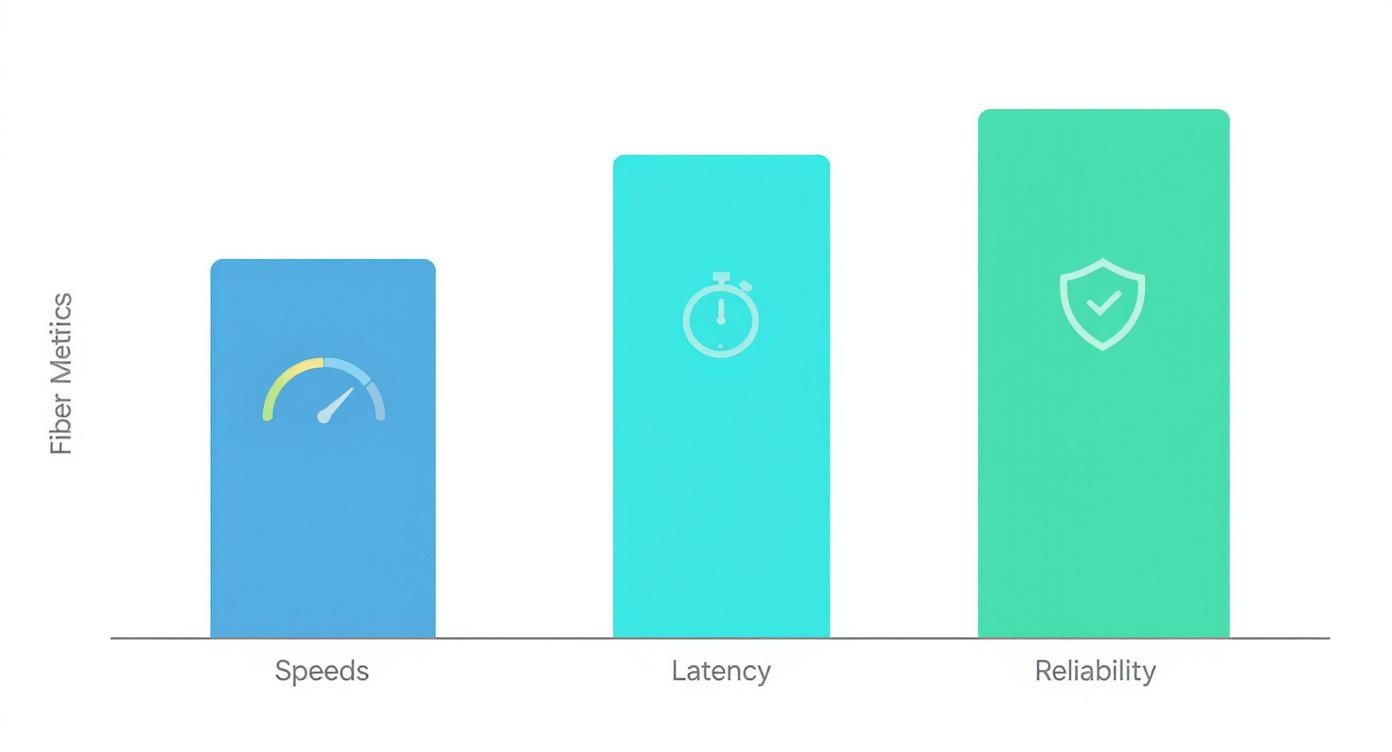Figuring out the best fiber internet providers isn't a one-size-fits-all deal. The perfect choice for a competitive gamer is totally different from what a remote worker or a family streaming on ten devices needs. The top providers are the ones that nail the balance of speed, low latency, and reliability for your specific situation. This guide will give you the tools to make that choice with confidence.
How to Choose the Right Fiber Internet Provider

Searching for the right fiber provider isn’t about finding some universally perfect service. It’s about matching what a provider does best with what you actually do online. The most important things to look at go way beyond the download speed they advertise on a billboard.
A remote professional, for example, absolutely needs fast upload speeds for clear video calls and sending huge files. For them, symmetrical speeds (where upload and download are the same) are a must-have. A serious online gamer, on the other hand, needs the lowest possible latency—or "ping"—to make sure their actions are instant. Raw speed is less important than a lag-free connection.
Figure Out What You Really Need
First things first, what are you actually doing on the internet every day? A house full of 4K TVs and smart gadgets needs a ton of bandwidth to keep everything running smoothly without buffering. If you're a content creator uploading massive video files, you need a powerful upload connection that won’t slow you down for hours.
The best way to pick a provider is to look at your own internet habits. Your day-to-day use will tell you if speed, latency, or rock-solid uptime is what you should be focused on.
For anyone working from home, it's also smart to look past speed and cost and check out a provider's reliability. Knowing they support things like backup and failover internet solutions can be a game-changer if your job depends on staying online. As you start to compare home internet plans, keep these different needs in mind.
What to Look For: A Quick Guide
Here’s a simple breakdown of what to focus on depending on who you are. This will help you judge providers based on real performance, not just the price tag.
| User Profile | What Matters Most | Why It's a Big Deal | Also Consider |
|---|---|---|---|
| Competitive Gamer | Low Latency (Ping) | Gives you instant, real-time response and gets rid of frustrating lag. | Symmetrical Speeds |
| Remote Worker | Symmetrical Speeds | Keeps your video calls smooth, cloud files synced, and big uploads fast. | Reliability (Uptime) |
| Streaming Household | High Download Speed | Stops buffering and lets everyone stream in 4K at the same time. | Data Caps |
| Content Creator | High Upload Speed | Slashes the time it takes to upload huge video files or other creative work. | Symmetrical Speeds |
When you're shopping for fiber internet, it's easy to get lost in the big, splashy speed numbers that providers plaster all over their ads. But to really understand what makes a great connection, you need to look under the hood at the metrics that actually matter for your day-to-day experience.
Getting a handle on these core performance stats is the key to telling the good from the great. It’s what separates a connection that sounds fast from one that feels fast, whether you're on a crucial video call or trying to snag a win in an online game.
Why Symmetrical Speeds Are a Game-Changer
Internet traffic isn't a one-way street; data is constantly flowing to and from your home or office. This is where symmetrical speeds come into play. It’s a simple concept: your upload speed is just as fast as your download speed. This is a signature feature of a true fiber-optic network.
Cable internet might give you decent download speeds, but the upload side is almost always a fraction of that. This creates a frustrating bottleneck for just about everything we do online today.
Think of it like trying to have a conversation where you can hear the other person perfectly, but you have to whisper your replies. That's an asymmetrical connection in a nutshell. Sending data out is just as important as pulling it in.
Here’s where you'll feel the difference:
- Remote Work: Video calls on Zoom or Teams are crystal clear, and big files sync to the cloud in a flash without grinding your entire network to a halt.
- Content Creation: Uploading a 4K video to YouTube can take minutes instead of hours. For streamers on Twitch, it means a stable, high-quality broadcast.
- Smart Homes: All those security cameras, smart speakers, and thermostats are constantly sending data. A strong upload ensures they all work together without a hiccup.
If you want to get deeper into this, our guide on why fiber internet is superior to cable internet breaks it down even further. This performance gap is a huge reason why fiber is taking over. In fact, fiber internet now passes over 56.5% of U.S. households, and it's quickly becoming the new standard.
The Critical Role of Low Latency
Speed tells you how much data you can move at once, but latency—or "ping"—tells you how fast it starts moving in the first place. It’s the round-trip time it takes for a signal to go from your computer to a server and back again. For anything happening in real-time, low latency is king.
Because fiber optics use light to send data through glass strands, the technology has incredibly low latency built-in. The result is a connection that feels sharp, snappy, and instantly responsive.
Key Insight: High bandwidth with high latency is like having a massive, 10-lane highway with a stoplight every hundred feet. You have the capacity for speed, but the constant delays make the trip a crawl. Fiber gets rid of the stoplights.
This matters most for activities where every millisecond counts:
- Online Gaming: In competitive games, low latency is the difference between a win and a loss. Your actions happen the instant you make them.
- Video Conferencing: It cuts out that awkward lag where you’re constantly talking over each other because the audio and video are out of sync.
- Cloud Applications: Latency and jitter are just as critical as raw speed for good cloud performance, making your web-based tools feel like they're installed right on your machine.
Uptime and True Reliability
At the end of the day, the fastest connection on earth doesn't mean a thing if it's down when you need it. Reliability, measured as uptime, is the foundation of a quality service. Fiber networks are simply more durable and less prone to interference from weather or electrical noise compared to old copper or coaxial cable lines.
Many business-grade fiber plans even offer a Service Level Agreement (SLA), which is a contract guaranteeing a certain level of uptime—often 99.9% or even 99.99%. While home plans might not have a formal SLA, the inherent stability of the fiber network means you'll see far fewer outages and a much more consistent connection. It's always worth asking a potential provider about their network's reliability record.
A Detailed Comparison of Major Fiber Providers
Now that you know what makes a quality connection, let's see how the big players in the fiber world actually perform. Finding the best fiber internet providers can feel overwhelming, but small differences in their network design, customer service, and pricing can make a huge difference in your daily online life.
We’re going to look past the flashy gigabit ads and dig into the real-world strengths of providers like AT&T and Verizon. This is all about the details that matter—helping you find the right fit whether you’re working from home, a serious gamer, or just running a busy smart home.
AT&T Fiber: The Symmetrical Speed Champion
AT&T has gone all-in on building out its fiber network with one major focus: symmetrical speeds. This makes them a powerhouse for anyone who uploads just as much as they download. Their commitment to equal upload and download speeds across most plans is a huge advantage that sets them apart.
This isn't just a technical spec on a brochure; it has a real impact on demanding tasks. Content creators pushing high-res video to the cloud, remote workers jumping from one video call to the next, and anyone backing up large files will feel the difference immediately. AT&T’s network is built to handle that heavy two-way traffic without hitting a wall.
In fact, the data backs this up. When compared to competitors like Verizon, Xfinity, and Spectrum, AT&T consistently crushes it on upload performance. It delivers average upload speeds well into the triple digits, making it roughly 30% faster than its closest rival. You can explore more about U.S. broadband performance and see how the providers stack up.
Verizon Fios: The Consistency King
While AT&T often takes the crown for symmetrical speed, Verizon Fios has built its reputation on rock-solid reliability. As one of the first companies to roll out a massive fiber-to-the-home network, its maturity really shows. Customers constantly praise Fios for delivering the speeds they pay for, even when everyone in the neighborhood is online.
Verizon's real strength is providing a stable, high-quality connection you can count on. Performance studies often give Verizon top marks for "Consistent Quality," where it scores an impressive 83%. This metric shows how well the network handles demanding apps like HD streaming and group video calls without skipping a beat.
Key Takeaway: If you just want an internet connection that works—no fuss, no drama—then Verizon Fios is an incredible choice. It’s perfect for households where reliable streaming and smooth performance are more important than having the absolute fastest upload speed on the block.
This infographic breaks down the core metrics—speed, latency, and reliability—that truly separate the top fiber providers.

As you can see, speed might get all the attention, but it's latency and reliability that really create a great online experience.
Fiber Provider Performance Snapshot
To put things in perspective, let's look at a side-by-side comparison of the major players. This table should give you a quick feel for where each provider shines.
| Provider | Key Strength | Symmetrical Speeds | Typical Latency Range | Customer Support Reputation |
|---|---|---|---|---|
| AT&T Fiber | Leading Symmetrical Upload Speeds | Yes | 10–20ms | Generally good, has been improving |
| Verizon Fios | Unmatched Consistency & Reliability | Yes | 10–20ms | Often ranked highest in satisfaction |
| Premier Broadband | Local Service & Symmetrical Fiber | Yes | 5–15ms | Community-focused, highly responsive |
| Other National ISPs | Broad Availability (Often Cable) | Varies (Often No) | 20–40ms+ | Mixed; often depends on the region |
While this table gives a quick overview, your own experience can depend heavily on your specific location and needs.
Both AT&T and Verizon deliver incredibly low latency, which makes them fantastic for online gaming where every millisecond counts. When it comes to customer support, reviews can be all over the map depending on the region, but national surveys tend to give Verizon a slight edge in satisfaction.
Considering Other National Players
AT&T and Verizon may be giants, but they aren't the only ones in the game. Companies like Xfinity and Spectrum, mostly known for cable, are slowly rolling out fiber. The key here is to make sure you're getting a true fiber-to-the-home connection, because they often market "fiber-backed" hybrid networks that don't give you symmetrical speeds.
When you're shopping around for any of the best fiber internet providers, be sure to ask these direct questions:
- Is this a 100% fiber-optic connection all the way to my house?
- Are the advertised speeds symmetrical (the same for upload and download)?
- Are there any data caps on this plan?
- What is the typical latency or ping time for your network right here in my area?
Getting straight answers will help you cut through the marketing fluff and understand exactly what you're paying for. It’s the best way to make sure you're comparing apples to apples and choosing based on facts, not just promises.
How to Match a Fiber Provider to Your Needs
Technical specs like speed and latency are a good start, but they don't tell you the whole story. The best way to find the right fiber provider is to match those numbers to what you actually do online. A plan that’s perfect for a family that loves to stream movies might be a terrible fit for a professional working from home.
This is why we need to think in terms of user profiles. By figuring out your main online activities, you can focus on the performance details that will make the biggest difference in your daily life. It’s a way to cut through all the marketing noise and choose an internet service based on your real-world needs.
For the Competitive Gamer Latency Is Everything
If you're a competitive gamer, one number matters more than any other: low latency. Sure, high download speeds are great, but it’s that instant response time—also known as low ping—that separates a win from a frustrating loss. In a fast-paced game, a delay of just a few dozen milliseconds is the difference between making the shot and seeing the "Game Over" screen.
Fiber internet is built for gaming. Because it sends data using light, it delivers incredibly low ping times. When looking at providers, gamers should hunt for a connection that consistently provides latency under 20ms. A 300 Mbps fiber plan with 5-15ms of latency will always beat a gigabit cable plan with 40ms of latency when it comes to gaming performance.
People often make the mistake of choosing a plan based only on download speed. For gaming, a stable, low-ping connection is way more important than raw bandwidth because it ensures your moves register on the server instantly.
For the Remote Professional Upload Speed and Uptime Are Key
Working from home has completely changed what we need from our internet connection. For professionals, the internet isn't just for fun—it's a critical tool for getting work done. Two things are absolutely essential: symmetrical upload speeds and guaranteed uptime.
High upload speed is a must for:
- Clear Video Calls: It keeps your video and audio sharp, so you don't freeze or drop during important meetings.
- Fast File Syncing: Uploading large project files to services like Dropbox or OneDrive takes minutes, not hours.
- Smooth Collaboration: Working on shared documents in real-time feels quick and responsive.
If you work from home, you should look for providers that offer symmetrical plans, where your upload speed is just as fast as your download speed. Reliability is also huge. You need a provider with a solid network, because outages can hurt your productivity and even your professional reputation.
For the Content Creator and Streamer Upload Is Your Lifeline
Just like a remote worker, a content creator’s entire job depends on upload performance. Whether you're a YouTuber uploading 4K videos, a Twitch streamer broadcasting live, or a photographer syncing huge photo albums to the cloud, a slow upload speed will kill your workflow.
Think about it: you spend hours editing a video, only for it to take another four hours just to upload. A symmetrical fiber connection can slash that upload time by over 90% compared to a standard cable plan. For live streamers, a strong and steady upload stream is the only way to deliver a high-quality, lag-free broadcast to your audience.
For creators and streamers, choosing a provider with powerful symmetrical speeds is the most important decision you can make. A 500/500 Mbps plan is often much more useful than a 1000/35 Mbps plan, even though the download speed is lower.
For the Smart Home Enthusiast Consistency Is Crucial
A modern smart home can have dozens of devices connected all at once. Security cameras, video doorbells, smart speakers, and thermostats are all constantly talking to the internet. While one device might not use much bandwidth, all of them together require a stable and consistent connection to work properly.
The key for a smart home owner is having enough bandwidth to handle everything at once without slowing down. A basic plan might start to struggle when a few 4K security cameras are uploading video while someone else is trying to stream a movie.
A mid-tier fiber plan, somewhere around 300 to 600 Mbps, is usually the perfect fit. It gives you plenty of power for all your smart devices to run smoothly without getting in the way of other things like streaming or gaming. The natural reliability of fiber also means your devices will stay connected and responsive whenever you need them.
Why Premier Broadband Excels in Performance

It’s one thing to talk about speed, but it’s another to deliver real-world performance when you need it most. When you look at the best fiber internet providers, it’s the details that separate good from great. Let’s connect the dots and show you exactly how Premier Broadband’s network is built for people who depend on their internet every single day.
We’re not just chasing big download numbers. Our network is engineered for the complete online experience—from competitive gaming and 4K streaming to running a business from your home office.
Symmetrical Speeds for Uncompromised Productivity
If you work from home, create content, or constantly share large files, upload speed isn't just a nice-to-have feature; it’s your lifeline. Slow uploads create frustrating bottlenecks, making video calls choppy and turning a simple file transfer into a coffee break you never wanted. Premier Broadband gets rid of that headache with true symmetrical fiber speeds.
Symmetrical means your upload speed is just as fast as your download. A 500 Mbps plan gives you 500 Mbps down and 500 Mbps up. This makes your work-from-home setup feel seamless. You can upload huge project files in minutes, not hours, and join video meetings with crystal-clear quality.
Key Insight: Premier Broadband’s commitment to symmetrical fiber empowers you to be a creator and collaborator, not just a consumer. Our network is built for the two-way traffic that modern life demands.
This shift to fiber is happening worldwide. Fiber-optic technology now makes up over 36% of the global fixed broadband market because users demand better speed and reliability.
Ultra-Low Latency for a Competitive Edge
For gamers, there’s one number that matters more than any other: ping. High latency creates the kind of lag that can cost you the match, no matter how fast your download speed is. Because our network is 100% fiber from end to end, we can minimize latency and give you the split-second response times you need.
Our network’s latency typically stays in the 5–15ms range, giving you a serious competitive advantage. Your in-game actions happen the instant you make them, making your connection feel incredibly sharp and responsive. And it's not just for gaming—low latency makes everything you do online, from video calls to just browsing websites, feel faster.
Local Service and Dedicated Support
Great technology is only half the story. As a provider focused on the communities we serve, we back up our network with responsive, local support. When you have a question, you’re not dialing an impersonal call center halfway across the country. You're talking to a local team that understands your area and is dedicated to helping you.
Choosing Premier Broadband means you’re investing in a service built for top-tier performance and supported by people who actually care. To see how we can serve your home, check out our residential fiber internet offerings. We’re here to provide a connection built not just for today, but for whatever comes next.
Frequently Asked Questions About Fiber Internet
Even after learning what makes a great fiber connection, you might still have a few questions. We get it. Switching your internet service is a big deal for your home or business, so it pays to have all the facts straight. Here are some direct answers to the questions we hear most often from people looking for the best fiber internet providers.
Our goal is to clear up any lingering confusion you might have. From what happens during installation to whether gigabit speeds are overkill, these answers should help you move forward with confidence.
What Is the Real Difference Between Fiber and Cable Internet?
The biggest difference comes down to the technology itself, which directly impacts performance. Fiber internet uses light pulses traveling through tiny glass strands—a method that is ridiculously fast and stable. This design also allows for symmetrical speeds, which just means your upload and download speeds are the same.
Cable internet, on the other hand, runs on the same old copper coaxial lines that deliver TV service. While modern cable can offer decent download speeds, uploads are often just a tiny fraction of that. Plus, since you’re usually sharing that connection with your entire neighborhood, your service can bog down during peak hours when everyone is online.
Fiber's design is just fundamentally better for moving data. Fiber optic lines carry way more bandwidth than copper, are less prone to interference, and give you a rock-solid, low-latency connection.
Is Professional Installation Required for Fiber Internet?
Yes, in almost every situation, you'll need a professional to handle the installation. Unlike cable or DSL that might use wiring that's already in your house, a new fiber connection needs its own dedicated line run directly to your home or office. A technician has to physically install this fiber-optic cable and set up an Optical Network Terminal (ONT).
This ONT is a small box that translates the light signals from the fiber line into an electrical signal your router can use. It’s definitely more involved than a simple cable hookup, but it's the only way to guarantee you get the full speed and reliability that a true fiber-to-the-home connection offers.
Do I Really Need Gigabit Speeds at Home?
Honestly, for most homes, a gigabit (1,000 Mbps) plan is more of a luxury than a necessity. It's awesome for future-proofing your home and perfect if you have multiple power users all gaming, streaming 4K video, and running dozens of smart devices simultaneously.
For most families and people working from home, however, a plan somewhere in the 300 to 600 Mbps range is the sweet spot. That’s plenty of bandwidth for smooth 4K streaming, lag-free video calls, and running a smart home without hitting any bottlenecks. You can get all the benefits of fiber without paying for extra bandwidth you might not even use.
How Can I Find Fiber Providers in My Area?
The surest way to find out who offers fiber is to go straight to the source. Visit the websites of providers in your area, like AT&T, Verizon, and local specialists like Premier Broadband. They all have address lookup tools that will tell you instantly if they can service your location.
You can also use broader search tools, like the FCC's National Broadband Map. These sites let you pop in your address or ZIP code to see a list of every ISP—fiber, cable, satellite, and more—that serves your specific location. It's a great first step to discovering which of the best fiber internet providers are available to you.
Ready to experience the difference a 100% fiber network can make? Premier Broadband delivers the symmetrical speed, ultra-low latency, and reliability you need for gaming, remote work, and streaming. Check your availability and find the perfect plan for your home or business today.




